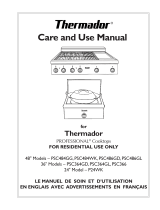
Part # 4523104 Rev 3 (03/04/10) Page 13
MAINTENANCE AND CLEANING
Seasoning
Griddle
A. Remove all factory applied protective material by
washing with hot water, mild detergent or soap solution.
B. Apply a thin coat of cooking oil to the griddle surface,
about one ounce per square foot of griddle surface.
Spread over the entire griddle surface with a cloth to
create a thin lm. Wipe o any excess oil with a cloth.
C. Light all burners, set at the lowest possible setting. Some
discoloration will occur when heat is applied to steel.
D. Heat the griddle slowly for 15 to 20 minutes. Then wipe
away oil. Repeat the procedure 2 to 3 times until the
griddle has a slick, mirror like nish. Do this until you have
reached the desired cooking temperature.
IMPORTANT: Do not set to a high position (on valve control)
or 450° (on thermostat control) during “break-in” period
NOTE: Steel griddle surface will tone (blue discoloration)
from heat. This toning will not diminish function or operation
and it is not a defect.
The griddle will not require reseasoning if it is used properly.
If the griddle is over heated and product begins to stick to
the surface it may be necessary to repeat the seasoning
process again. If the griddle is cleaned with soap and water it
will be necessary to reseason the griddle surface.
Cast Iron top Grates
First, remove the cast iron top grates from the range. Wash
the cast iron top grates thoroughly with a mild soap and
warm water. Dry the cast-iron top grates thoroughly with a
clean cloth. Immediately after drying, season the top grates
lightly with a non-toxic oil, (Liquid vegetable oil or Pam spray
oil) WARNING; DO NOT SEASON THE TOP GRATES WHILE ON
THE RANGE TOP! Seasoning grates on the range top over an
open ame could cause a ash re. After seasoning, replace
the top grates onto the range. Turn all the range top sections
“ON LOW”. Allow the top sections to burn in this manner
for at least 20 minutes before using pots or pans on the top
grates. SEASONING OF THE TOP GRATES WILL BE REQUIRED
WHENEVER THEY HAVE BEEN CLEANED. FAILURE TO SEASON
GRATES WILL CAUSE RUSTING.
Stainless Steel
For routine cleaning, wash with a hot water and detergent
solution. Wash just a small area at a time or the water will
evaporate leaving the chemicals behind causing streaking.
Rinse the washed area with a clean sponge dipped in a
sanitizing solution and wipe dry with a soft clean cloth
before it can dry.
Use a paste (of water and a mild scouring powder) if you
have to, but never rub against the grain. All stainless steel has
been polished in one direction. Rub with the polish lines to
preserve the original nish. Then thoroughly rinse as before.
To prevent ngerprints there are several stainless steel
polishes on the market that leave an oily or waxy lm. Do not
use on surfaces that will be in contact with food.
Stainless steel may discolor if overheated. These stains can
usually be removed by vigorous rubbing with a scouring
powder paste.
Use only stainless steel, wood or plastic tools if necessary
to scrape o heavy deposits of grease and oil. Do not use
ordinary steel scrapers or knives, as particles of the iron may
become imbedded and rust. NEVER USE STEEL WOOL.
Either a typical bleach solution or hot water can be used to
sanitize stainless steel.
Oven Interior (Porcelain Enamel)
NOTE: Disconnect line cord (if applicable from power supply
before cleaning or servicing.
1. Before cleaning oven interior, remove all oven racks
and guides (if “RC” base). Oven racks and guides can be
cleaned with a mild soap and warm water or run through
dish washer.
2. The porcelain interior can be cleaned with oven cleaners
such as “Easy O, or “Dow Oven Cleaner”.
Follow product manufacturer’s instructions for proper use.
Open Top Burners
Cleaning of the range top burner is a simple procedure, and,
if done at regular intervals will prolong the life of the range
and ensure good ame characteristics.
1. The most common problem with open burner ranges is
spillage. Once the burner ports are partially plugged with
food, the air-to-gas mixture is disturbed and results in an
inecient burner.
2. Wipe any spills as they occur.
3. Grids and trays should be removed daily, washed, rinsed
and dried thoroughly.







